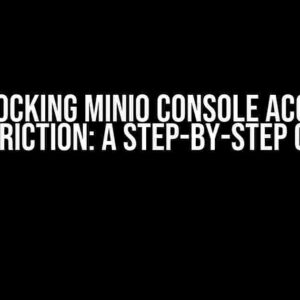Are you scratching your head, wondering why your AWS bucket URL is working seamlessly, but your A-record is refusing to cooperate? Well, worry not, dear reader, for you’re not alone in this conundrum! In this article, we’ll delve into the world of AWS, DNS, and A-records to help you troubleshoot and resolve this pesky issue.
Understanding the Basics
Before we dive into the nitty-gritty, let’s quickly review some fundamental concepts:
- AWS Bucket URL: This is the URL provided by AWS to access your S3 bucket. It’s usually in the format
s3.amazonaws.com/your-bucket-name. - A-record: Also known as a DNS A record, this is a type of DNS record that maps a domain name to an IP address.
- DNS (Domain Name System): This is the phonebook of the internet, responsible for translating human-readable domain names into IP addresses.
Why Does the AWS Bucket URL Work But Not the A-record?
There are several reasons why your AWS bucket URL might be working, but your A-record is not. Let’s explore some possible explanations:
-
Incorrect DNS Configuration
One of the most common reasons is a misconfigured DNS. When you set up an A-record, you need to ensure that it points to the correct IP address. Double-check your DNS settings to ensure that the A-record is correctly configured.
; Correct DNS configuration example.com. IN A 52.219.125.155 -
Propagation Delay
When you update your DNS settings, it can take some time for the changes to propagate globally. This delay can cause issues with your A-record. Try waiting for a few hours or even a day to see if the issue resolves itself.
-
Bucket Permissions
Make sure that your bucket has the correct permissions set up. If your bucket is not publicly accessible, you’ll need to configure permissions to allow access via the A-record.
Bucket Permission Description Public Read Allows anyone to read objects in the bucket Public Write Allows anyone to write objects to the bucket -
AWSRegion and Endpoint
If you’re using a custom domain, ensure that you’re using the correct AWS region and endpoint. For example, if your bucket is in the US-West-2 region, your endpoint should be
s3-us-west-2.amazonaws.com.; Correct endpoint for US-West-2 region example.com. IN A s3-us-west-2.amazonaws.com -
SSL/TLS Certificate
If you’re using SSL/TLS encryption, ensure that your certificate is correctly configured and installed. A misconfigured certificate can cause issues with your A-record.
Troubleshooting Steps
Now that we’ve covered some possible explanations, let’s dive into some troubleshooting steps to help you resolve the issue:
-
Verify DNS Configuration
Use tools like
digornslookupto verify that your DNS configuration is correct.dig example.com +short -
Check Bucket Permissions
Verify that your bucket has the correct permissions set up. You can do this using the AWS Management Console or the AWS CLI.
aws s3api get-bucket-policy --bucket example-bucket -
Test with a Different Domain
Try testing your A-record with a different domain to rule out any issues with your custom domain.
-
Verify AWS Region and Endpoint
Double-check that you’re using the correct AWS region and endpoint.
-
Check SSL/TLS Certificate
Verify that your SSL/TLS certificate is correctly configured and installed.
Conclusion
In conclusion, resolving the issue of an AWS bucket URL working but not the A-record requires a methodical approach. By understanding the basics, identifying possible explanations, and following troubleshooting steps, you should be able to resolve the issue and get your A-record working smoothly.
Remember to double-check your DNS configuration, bucket permissions, AWS region, and endpoint, as well as your SSL/TLS certificate. If you’re still stuck, feel free to reach out to AWS support or a seasoned devops expert for further assistance.
By following the steps outlined in this article, you’ll be well on your way to resolving the mystery of the non-functional A-record and getting your AWS bucket URL working seamlessly with your custom domain.
Happy troubleshooting, and may the AWS force be with you!
Frequently Asked Question
Are you stuck with an AWS bucket URL that works like a charm but an A-record that’s refusing to play nice? Don’t worry, you’re not alone! Here are some FAQs to help you troubleshoot the issue:
Q1: What’s the difference between a bucket URL and an A-record?
A bucket URL is a unique URL assigned to your AWS S3 bucket, whereas an A-record is a DNS record that maps a domain name to an IP address. Think of it like a virtual address vs. a physical address. The bucket URL is like a PO box, and the A-record is like the street address that directs traffic to the PO box.
Q2: Why does my bucket URL work but not my A-record?
This might be because your A-record is not correctly configured or propagated. Double-check that your A-record is pointing to the correct IP address and that it’s properly set up in your DNS provider. Additionally, propagation can take some time, so give it a few hours before retrying.
Q3: What’s the deal with AWS Region-specific endpoints?
AWS has region-specific endpoints, which can affect your A-record setup. Make sure you’re using the correct endpoint for your region. For example, if your bucket is in us-west-2, your A-record should point to `s3-us-west-2.amazonaws.com`.
Q4: Can I use a CNAME record instead of an A-record?
Yes, you can use a CNAME record instead of an A-record. CNAME records are more flexible and can handle DNS changes more easily. However, keep in mind that CNAME records can’t be used at the apex of a domain (e.g., example.com), only for subdomains (e.g., blog.example.com).
Q5: What if I’ve tried everything and it still doesn’t work?
Don’t panic! If you’ve tried all the above steps and your A-record is still not working, it’s time to reach out to AWS support or your DNS provider’s support team. They can help you troubleshoot the issue and get your A-record up and running in no time.



